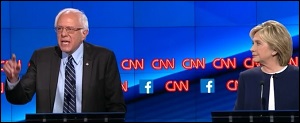By Pam Martens and Russ Martens: October 14, 2015
In the minds of millions of viewers, Hillary Clinton came across in last night’s Democratic debate on CNN as polished, articulate and knowledgeable about the issues. But for those of us who understand that the greatest threat to America is not some foreign power but home-grown financial terrorists wielding trillions of dollars in high-risk derivatives in taxpayer-insured banks on Wall Street, she is the same old problem, not the solution.
Senator Bernie Sanders of Vermont, on the other hand, who calls himself a Democratic Socialist, was in Congress leading the fight to stop the repeal of the Glass-Steagall Act in 1999 and is still leading the charge to restore it before the next financial crash destroys what’s left of the U.S. economy. (The Glass-Steagall Act prohibits insured banks from being affiliated with high risk investment banks or stock brokerage firms.)
It was during the exchange between Sanders and Clinton on the Glass-Steagall Act that the defining difference between the two emerged: Clinton admits to listening to “experts” who told her that the real danger is not the mega banks but “shadow banking.” She said her plan “is more comprehensive” than Sanders and that it would “empower regulators to break up big banks if we thought they posed a risk.”
The above quote from Clinton is fatal to her candidacy. The “experts” she’s listening to apparently don’t know that regulators have had the ability to break up the big banks since the Dodd-Frank reform legislation was passed in 2010. The regulators just don’t have the guts to take on the Wall Street lobby and their sycophants in Congress. Senator Elizabeth Warren has lectured the Federal Reserve Chair, Janet Yellen, in Senate hearings on using that authority instead of allowing Wall Street mega banks to flunk their stress tests and simply come back the next year and try to get a passing grade.
It’s also fatal to Clinton’s candidacy that she’s bought into the idea that shadow banking is the threat and not the Wall Street banks with $1 to $2 trillion in assets. Yes, their shadow banking customers may get into trouble and threaten their balance sheets, or their shadow banking counterparties may get into trouble and threaten their balance sheets, but it’s the mega Wall Street investment banks with insured deposits backed by the taxpayers that ultimately pose the real threat to the stability of the financial system, the U.S. economy, and the already crushing national debt that exploded to resuscitate the economy the last time Wall Street cratered it in 2008 and 2009.
There is also an embarrassing naiveté to Hillary Clinton’s grasp of what it takes to effectively rein in Wall Street. Here’s how she explained on the debate stage what she’s done in the past to tackle Wall Street:
“You know, I — I respect the passion and intensity. I represented Wall Street, as a senator from New York, and I went to Wall Street in December of 2007 — before the big crash that we had — and I basically said, ‘cut it out! Quit foreclosing on homes. Quit engaging in these kinds of speculative behaviors.’”
Anyone who thinks that wagging a finger at Wall Street and telling them to “cut it out” is going to get the job done has just not been paying attention. Just this past May, only seven years after collapsing the U.S. financial system from the weight of their own corruption, two U.S. based Wall Street banks, JPMorgan Chase and Citigroup, were charged with criminal felonies for rigging foreign currency markets and admitted to the charge. More collusive activity by Wall Street mega banks remains under investigation by the U.S. Justice Department.
Hillary’s experts are clearly not the experts at the U.S. Treasury’s Office of Financial Research (OFR) – the office that advises the top U.S. regulators that sit on the Financial Stability Oversight Council. Just this past February, OFR released a report which found the following:
“…the default of a bank with a higher connectivity index would have a greater impact on the rest of the banking system because its shortfall would spill over onto other financial institutions, creating a cascade that could lead to further defaults. High leverage, measured as the ratio of total assets to Tier 1 capital, tends to be associated with high financial connectivity and many of the largest institutions are high on both dimensions…The larger the bank, the greater the potential spillover if it defaults; the higher its leverage, the more prone it is to default under stress; and the greater its connectivity index, the greater is the share of the default that cascades onto the banking system. The product of these three factors provides an overall measure of the contagion risk that the bank poses for the financial system.”
Who posed the greatest threat under this study? The two banks that would admit to criminal felony conduct just three months later – JPMorgan Chase and Citigroup.
Hillary Clinton is wrong on her facts and wrong for America at one of the most dangerous financial moments in our Nation’s history. Her husband signed the legislation in 1999 that repealed the Glass-Steagall Act. He has stated that this action had nothing to do with causing the 2008-2009 crash. For Hillary Clinton to restore this vitally needed legislation would eviscerate her husband’s legacy as President. She is a conflicted candidate on that basis as well as because her campaign is being financed by Wall Street powerhouses and their legions of law firms. Sanders is being financed by the little guy who wants to restore democracy in America.
It may take a Democratic Socialist to save capitalism and take back America from the death grip of the 1 percent.


